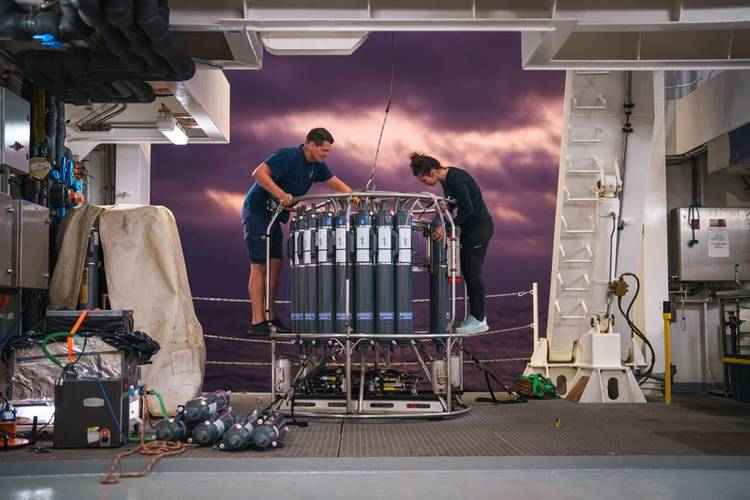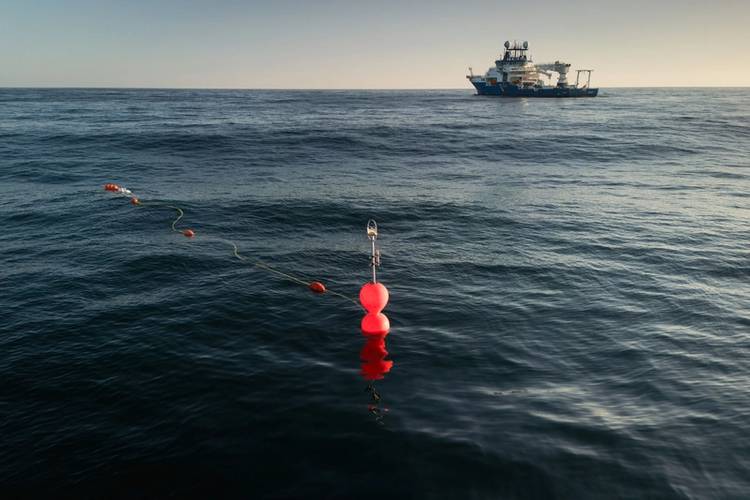DISCOVERY: New Tech Aids Understanding of the Oxygen Minimum Zone
Using a new technology called a mini trace analyzer insitu logger, or mTail, an international team of scientists on a Schmidt Ocean Institute expedition has found sporadic pockets of water with trace amounts of oxygen in an area of the Southeast Pacific where oxygen has historically been below the limit of detection.
The discovery revises the understanding of microbes and nutrient cycling in a little-studied but important ecosystem, the Oxygen Minimum Zone (OMZ). Traditional oceanographic sampling equipment has been unable to detect oxygen in the core of the Southeast Pacific OMZ, leaving gaps in scientific knowledge on how this globally important ecosystem functions.
The mTail device is a trace oxygen profiler that the scientists attached to a rosette, that carries Niskin bottles, and a mooring, standard pieces of oceanographic research equipment. Drs. Morten Larsen and Bo Thamdrup of the University of Southern Denmark developed the device alongside Dr. Laura Bristow of the University of Gothenburg, Sweden. Traditional sampling equipment for studying oxygen is relatively
low-resolution compared to the mTail, resulting in inaccurate oxygen measurements in the OMZ.
OMZs extend from 100 to 1000 meters depth and are considered areas where oxygen concentration is beyond the detection limit for traditional equipment. The scientists’ application of multiple, custom-built technologies specifically designed for the OMZ offers a new paradigm for studying this globally important environment and new insights into how it functions.
 Maria Pachiadaki (Chief Scientist, Woods Hole Oceanographic Institution) and Lizt Osorio Pando (Student, Woods Hole Oceanographic Institution and Centro de Investigación Científica y de Educación Superior de Ensenada, Baja California) prepare the Microbial Sampler (filters and preserves samples in situ) for deployment.
Maria Pachiadaki (Chief Scientist, Woods Hole Oceanographic Institution) and Lizt Osorio Pando (Student, Woods Hole Oceanographic Institution and Centro de Investigación Científica y de Educación Superior de Ensenada, Baja California) prepare the Microbial Sampler (filters and preserves samples in situ) for deployment.
Credit: Alex Ingle / Schmidt Ocean Institute
“Life started on our planet without oxygen,” said Dr. Osvaldo Ulloa of the Instituto Millenio de Oceangrafíca, Chile, a principal investigator on this expedition, “While no large animals like fish and whales live here, the OMZ is thriving with microbes. This microbial ecosystem is likely the most analogous marine environment to the ancient ocean. By researching these invisible organisms and their ecosystem, we unlock key insights into what our planet likely looked like millions of years ago and how this environment may respond to a changing climate.”
The Southeast Pacific OMZ is a naturally occurring ecosystem off the west coast of South America. The Ocean’s physics and biology create a region with weak ocean circulation and high productivity, resulting in a large quantity of organic matter for microorganisms to consume. OMZs are likely growing due to climate change. Most large animals cannot live permanently in the OMZ due to insufficient oxygen, however, the zone is home to a vast thriving microbial ecosystem. When oxygen is unavailable, microbes use molecules like ammonia and nitrate for energy, releasing nitrous oxide as a byproduct — a greenhouse gas 245 times more potent than carbon dioxide.
 In the Wet Lab, Morten Larsen (Research Technician, University of Southern Denmark) tests and assembles an exceptionally sensitive oxygen sensor; it is highly sensitive compared to traditional sensors and is likely the most sensitive oxygen sensor applied in an oxygen minimum zone to date. It was fitted to the CTD rosette to enable extremely sensitive oxygen measurements to be made throughout the oxygen minimum zone.
In the Wet Lab, Morten Larsen (Research Technician, University of Southern Denmark) tests and assembles an exceptionally sensitive oxygen sensor; it is highly sensitive compared to traditional sensors and is likely the most sensitive oxygen sensor applied in an oxygen minimum zone to date. It was fitted to the CTD rosette to enable extremely sensitive oxygen measurements to be made throughout the oxygen minimum zone.
Credit: Alex Ingle / Schmidt Ocean Institute
“The impacts of finding trace oxygen have potentially far-reaching consequences for the OMZ microorganisms,” said Bristow. “When the oxygen appears, it supplies the microbial community with small but significant amounts of oxygen, which can impact the turnover of greenhouse gases in these systems, reshaping our conceptual understanding of how the oxygen minimum zone actually works.”
Dr. Maria Pachiadaki of Woods Hole Oceanographic Institution (WHOI) led the science team on the 34-day expedition, which included scientists from Chile, Spain, Mexico, the United Kingdom, Sweden, and Denmark. The research was conducted onboard Schmidt Ocean Institute’s R/V Falkor (too), where the team deployed several other novel technologies.
 Natalia Cisterna (Observer, Universidad de Valparaiso) assists with CTD operations on Research Vessel Falkor (too). "CTD" stands for conductivity, temperature, and depth, and refers to a package of electronic devices and samplers used to detect how the conductivity and temperature of water changes relative to depth.
Natalia Cisterna (Observer, Universidad de Valparaiso) assists with CTD operations on Research Vessel Falkor (too). "CTD" stands for conductivity, temperature, and depth, and refers to a package of electronic devices and samplers used to detect how the conductivity and temperature of water changes relative to depth.
Credit: Alex Ingle / Schmidt Ocean Institute
To study the microbial activity in the OMZ, the science team used another technology known as a Submersible Incubation Device (SID). The SID is an autonomous laboratory that measures microbial activity in the environment, allowing scientists to measure nutrient cycling under the conditions in which they naturally occur rather than attempting to simulate them back in the lab. The equipment is built with only glass and titanium, preventing oxygen contamination during experimentation. This particular SID was developed through an international collaboration of Drs Bristow, Thamdrup, and Larsen, as well as the lab of Dr. Pachiadaki of WHOI.
Other cutting-edge technologies tested during the expedition included a HyperPro multi-wavelength optical sensor, and a Pump Profiling System developed by Dr. Ulloa’s lab at the Instituto Millenio de Oceanografíca. These new technologies allowed the team to collect multiple types of data about an ecosystem invisible to the human eye. Data from the expedition will be further analyzed in onshore labs to determine the implications of sensing oxygen in the OMZ core.
“Until now, scientists have been challenged to measure low levels of oxygen in the ocean due to sampling limitations. This expedition was an exciting test of novel technology that pushed a critical boundary of detection and highlights the need for continuing innovation in Ocean research,” said Schmidt Ocean Institute Executive Director Dr. Jyotika Virmani. “The suite of technologies developed by Dr. Pachiadaki and her colleagues open the doors to an increased understanding of microbial processes and phenomenon in these expanding Oxygen Minimum Zones.”
 Gerardo García (Research Technician, Universidad de Concepción) and Sibille Améstica (Research Assistant, Pontificia Universidad Católica de Chile) work on an experiment in a portable laboratory on the aft deck to better understand the biology of microbes in Oxygen Minimum Zones. Dim red light is needed to work with light-sensitive microbes, such as phytoplankton, because it possesses lower energy compared to white light or light of shorter wavelengths. Red light facilitates the setup of experiments in which microbes will be exposed to specific light intensities, and it is maintained at a very low intensity to minimize photosynthetic activity during the experiment setup.
Gerardo García (Research Technician, Universidad de Concepción) and Sibille Améstica (Research Assistant, Pontificia Universidad Católica de Chile) work on an experiment in a portable laboratory on the aft deck to better understand the biology of microbes in Oxygen Minimum Zones. Dim red light is needed to work with light-sensitive microbes, such as phytoplankton, because it possesses lower energy compared to white light or light of shorter wavelengths. Red light facilitates the setup of experiments in which microbes will be exposed to specific light intensities, and it is maintained at a very low intensity to minimize photosynthetic activity during the experiment setup.
Credit: Alex Ingle / Schmidt Ocean Institute








































 August 2025
August 2025



